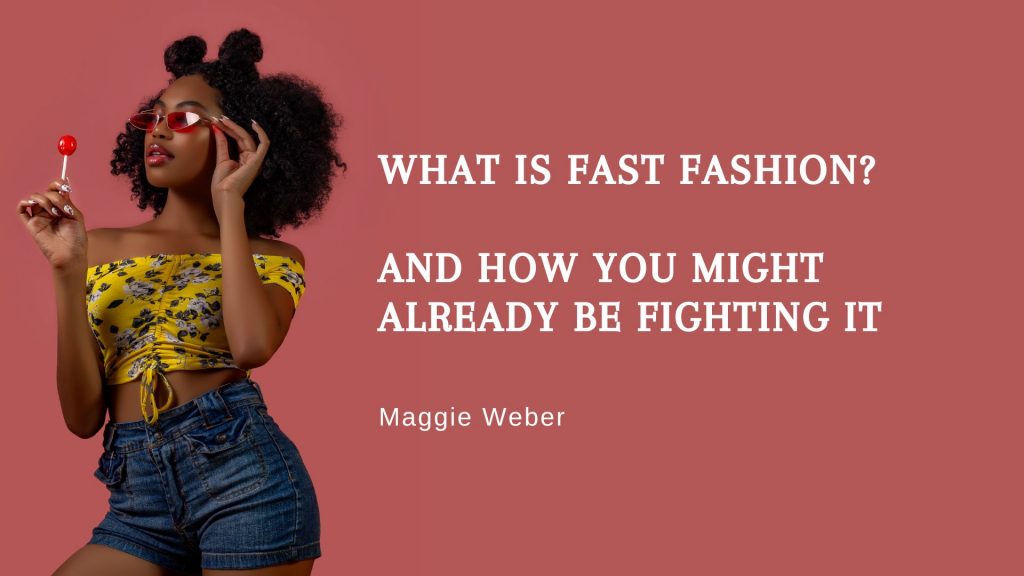 What is fast fashion and how might you already be fighting it?
What is fast fashion and how might you already be fighting it?
Sustainability, recycling, upcycling, and eco-friendliness are words that you’re likely to hear during Earth Month (April) if you go shopping for clothing this time of year. But are they just being used as buzzwords by the companies you shop with or are they being treated as the important and life-saving concepts that they really are?
What is fast fashion?
Fast fashion is first and foremost exactly that, fast. Designs are heavily influenced by pop culture, TV shows, movies, and social media, which as we all know, move pretty quickly. If something is a surprise hit, companies want to use that popularity to their advantage. Let’s use HBO’s Euphoria as an example.
Whether you watch the show or not, heck, even if you watch TV or not, you’ve definitely seen Euphoria’s fashion trends filtering into our culture and walking around on our streets. Cosmo magazine even did an article shortly after the show’s premiere titled, “How to Dress Like You’re in Euphoria”. When Maddy wears a Y2K look, the fans want it. Rue’s love of skater grunge has people flooding thrift stores and scouring the internet for similar styles. There’s a lot of money available for any retailer who can produce those garments fast enough to meet that demand. That’s where fast fashion comes in.
Brands like H&M and Shein have nearly perfected their process and can go from seeing a sunflower crop top on TV, to having a rack of them in their stores in under two weeks. They produce them fast enough to meet the demand, but also cheap enough that you don’t mind buying something that might only be popular for a few weeks.
We’ve become used to our fashion
We’ve become so used to such abundant and changing clothing that we also don’t seem to mind the quality or durability of what we buy. If you wear a shirt five times and the seam splits, who cares? One out of three women say that a piece of clothing is old after being worn twice, so we don’t mind replacing it with something new. In fact, we like it.
Who doesn’t feel more confident in a new outfit for a job interview? Who doesn’t feel more beautiful in a new dress for a wedding reception? We like new. We like different. And with so many new and different pieces that can fit into any budget, what’s the problem?
Grab your umbrella because my little black rain cloud and I are here to tell you.
The end results of fast fashion
Fashion is the second most polluting industry in the world.
Producing just one pair of jeans requires 1,800 gallons of water. That’s enough water for a single person to survive for 7 years. It also requires all sorts of chemicals and dyes that seep into the local ground and water. Producing clothing is also a pretty wasteful process with some companies discarding as much as 35% of the initial fabric they made. Clothing production is a huge environmental crisis, but the real crisis is the humanitarian one.
It’s estimated that 40 million people are enslaved worldwide to support the fast fashion industry. Even those who are paid, live on poverty wages and are forced to endure hazardous working conditions. It’s not hard to find gruesome instances of factory collapses, deadly fires, abuse of underage workers, rape, and other abject cruelties in workplaces around the world. In fact, I bet you’ve heard a lot of this before because those stories are pretty hard to avoid.
wages and are forced to endure hazardous working conditions. It’s not hard to find gruesome instances of factory collapses, deadly fires, abuse of underage workers, rape, and other abject cruelties in workplaces around the world. In fact, I bet you’ve heard a lot of this before because those stories are pretty hard to avoid.
Sadly, the environmental and humanitarian crises don’t end when the clothing is in your closet. For most garments, they won’t end for tens of thousands of years.
Americans throw out a lot of our unwanted clothing. I mean, a lot. Some estimates say about 80 pounds per person, every year. For the record, this is what 80 pounds of textile look like:
(After 80 pounds I ran out of clothing to collect. And please ignore my chaotic home…)
Where does it all go?
More than 80% ends up in landfills and incinerators.
When clothing is burned it releases carbon dioxide and other greenhouse gasses into the air. Even clothing that you donate can end up hurting the environment. Thrift stores have high-quality standards for the pieces they sell. Most only put out about 10-15% of the donations they receive, the rest are sold to third-world countries.
There is a bustling second-hand market overseas. Small sellers in countries like Malaysia and Kenya buy bails (compressed lots) of clothing from wholesale distributors. They pick through them, keep the best quality items and resell them. For years, this was seen as a great solution to our overabundance and a great way to support local economies overseas. But as the quality of our clothing declines, and production continues to increase, the profit margins for those sellers is shrinking.
We all know that you can get more money for a 100% silk Diane Von Furstenberg dress than you can for a pilly No Boundaries polyester tank top. The same is true in a Nairobi market, as it is in my Poshmark closet. But we are producing, and throwing away, a lot more low-quality items. Clothing production has doubled in the last 15 years and it doesn’t show signs of slowing down in the future. That’s in part because we each buy an average of 60% more clothing today than we did 10 years ago and keep them half as long.
There are literal mountains of clothing in third-world countries that grow every day with shipments of unwanted pieces. Locals named the long tangles of clothing that wash up on shore “tentacles” because that’s what they resemble. These “tentacles” can be up to 30 feet long. They are mixes of clothing that gather in the waves and wash up on shore, often perfect homes for mosquito nests. Perhaps worst of all is when piles of clothing catch on fire, darkening the skies, releasing greenhouse gasses, and flooding chemicals into the lungs of the local population.
So, what do we do?
Looking at articles and photos online might make you want to sit and cry at the seeming hopelessness, but I do have some good news. You might already be part of the solution!
 The easiest steps are to simply buy less, and keep the clothing you have for longer. I say “keep” because that doesn’t mean the only way to help is by wearing your clothing more times. (Although. obviously, that’s good too!) If you use a worn-out 100% cotton T-shirt as a hair wrap for when you get out of the shower, congratulations – you have extended the life of that clothing and reduced its carbon footprint by 72%! Plus, it’s better for your hair!
The easiest steps are to simply buy less, and keep the clothing you have for longer. I say “keep” because that doesn’t mean the only way to help is by wearing your clothing more times. (Although. obviously, that’s good too!) If you use a worn-out 100% cotton T-shirt as a hair wrap for when you get out of the shower, congratulations – you have extended the life of that clothing and reduced its carbon footprint by 72%! Plus, it’s better for your hair!
You can braid T-shirts into dog toys, easily turn old sweaters into cat beds, and do hundreds of other easy things to upcycle old garments and keep them out of the trash.
As The Hippy Edit recently said on The Seller Community Podcast, if you started a reselling business, whether you know it or not, you started a recycling business! Every single sale you make is one person choosing resale instead of fast fashion. Every single sale matters!
You can view the overabundance of clothing as a problem, which, okay, fair. Or, you can view it as an opportunity to gain financial freedom, teach the next generation about recycling and practice your upcycling skills.
Learn more
Listen to two awesome resellers talk all things sustainable:
Follow my reselling journey, or read my books: https://linktr.ee/refashionedhippe
If you want to learn more about fast fashion, click the link below. “Dead white man’s clothes” is the best article I have ever read on the subject: https://www.abc.net.au/news/2021-08-12/fast-fashion-turning-parts-ghana-into-toxic-landfill/100358702




